|
Thursday, April 27
Yangtze River
After the hectic days
in Beijing and Shanghai, we really enjoyed this day-long leisurely
cruise without any onshore excursions. The Yangtze River between Wuhan
and Yichang City is a slow-moving, very wide river that runs through
fairly level agricultural land. It is the longest river in China and the
third longest in the world, 3,900 miles long. During the day, the shipís
doctor, George Zhang, presented a talk about traditional Chinese
medicine, including acupressure and acupuncture. Cissy, our river guide,
gave a lecture on the Three Gorges Dam project. She could talk nonstop
without ever hardly taking a breath. At 5:30, we were invited to the
sundeck for the Captainís welcoming champagne party. In the evening,
the ship staff entertained us with traditional Chinese folk songs and
dances at the Sheena Follies in the ballroom.
Friday, April 28 Three
Gorges Dam
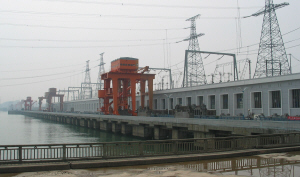 At about 9 am we
encountered the first dam on the Yangtze River, the Gezhouba Dam and ship
lock located at Yichang City, about 23 miles downstream from the Three
Gorges Dam. The Gezhouba Dam was
completed in 1988 and was the first large scale dam on the
Yangtze. It is longer than the Three
Gorges Dam (1.6 mi.) but only about 150 feet high. The maximum
difference in water levels above and below the dam is 88 feet.
Three, one-stage ship locks provide for the passage of up to 10,000-ton passenger
and cargo ships. It took about an hour to pass through this ship
lock. On our way towards the Three
Gorges Dam, we were intrigued
to see a two ship yards along the banks of the river where large ferries
and barges were being built with essentially no equipment or other
facilities evident. We wondered how these ships would be launched
from the river bank into the water. At about 9 am we
encountered the first dam on the Yangtze River, the Gezhouba Dam and ship
lock located at Yichang City, about 23 miles downstream from the Three
Gorges Dam. The Gezhouba Dam was
completed in 1988 and was the first large scale dam on the
Yangtze. It is longer than the Three
Gorges Dam (1.6 mi.) but only about 150 feet high. The maximum
difference in water levels above and below the dam is 88 feet.
Three, one-stage ship locks provide for the passage of up to 10,000-ton passenger
and cargo ships. It took about an hour to pass through this ship
lock. On our way towards the Three
Gorges Dam, we were intrigued
to see a two ship yards along the banks of the river where large ferries
and barges were being built with essentially no equipment or other
facilities evident. We wondered how these ships would be launched
from the river bank into the water.
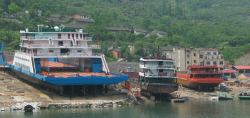 We arrived a short time later at
San Dou Ping. Here we disembarked and took a bus to visit the Three
Gorges Dam, the largest dam in the world at 600 ft high and nearly 1Ĺ
miles long. The official cost has been put at $22.5 billion (180 billion
Yuan) but critics and others have suggested the real cost may be as high
as $75 billion. Itís likely the true cost of the entire project is
somewhere in between.
Inside the visitor center was a
huge model of the entire project. We arrived a short time later at
San Dou Ping. Here we disembarked and took a bus to visit the Three
Gorges Dam, the largest dam in the world at 600 ft high and nearly 1Ĺ
miles long. The official cost has been put at $22.5 billion (180 billion
Yuan) but critics and others have suggested the real cost may be as high
as $75 billion. Itís likely the true cost of the entire project is
somewhere in between.
Inside the visitor center was a
huge model of the entire project.

An observation site above the dam provided a great
panoramic view of the dam and locks.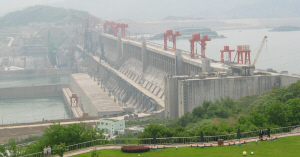
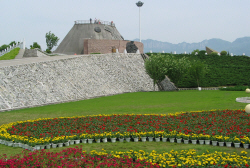
This concrete dam will
create a reservoir 360 miles long that will submerge 13 cities, 140
towns, 1352 villages, 657 factories and approx. 75,000 acres of
cultivated land. One and a third million people have been or will be
relocated. Construction started in 1994 and when completed in 2008, 26
hydro turbine generators were supposed to provide 15% of Chinaís
electricity, but because of China's booming economy, that figure has
been revised down to 3%.
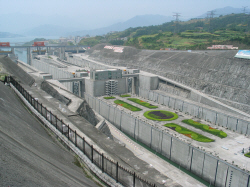 Twin
5-stage locks, each 60 feet high, will accommodate 10,000 ton ships.
So
far, the water height behind the dam has risen about 200 feet requiring
the operation of four of the five locks. Eventually, the water will rise
another 100 feet to a maximum height of 574 ft above sea level. Not yet
completed is a ship elevator that will be able to lift a 3,000 ton ship
as much as 370 feet in 30 minutes, while it literally floats in a 60 x
400 ft. tub. Twin
5-stage locks, each 60 feet high, will accommodate 10,000 ton ships.
So
far, the water height behind the dam has risen about 200 feet requiring
the operation of four of the five locks. Eventually, the water will rise
another 100 feet to a maximum height of 574 ft above sea level. Not yet
completed is a ship elevator that will be able to lift a 3,000 ton ship
as much as 370 feet in 30 minutes, while it literally floats in a 60 x
400 ft. tub.
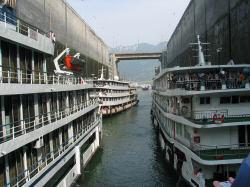
It took us about three
hours to pass through the four locks. Each lock chamber is large enough
(112 x 900 ft) to accommodate four ships the size of the Princess
Sheena. As we passed through the locks, there were a total of seven
ships of various types and sizes in our lock chamber. It was fascinating
to watch how quickly they can fill those huge "tubs". Once we
were inside and the gates were closed, the water level rose 60 feet in
perhaps as little as 10 minutes.
 Unfortunately, because
we were delayed getting through the locks, it was after 6 pm before we
entered the first of the Three Gorges, the Xiling Gorge -- a couple
hours later than we would have liked. The Xiling Gorge is the longest of
the gorges (41 mi) and it was getting dusk before we passed all the way
through. The entire Three Gorges area, also called Sanxia, is a
mountainous barrier of solid limestone that extends from Yichang to
Baidi Cheng, a distance of about 150 miles. Unfortunately, because
we were delayed getting through the locks, it was after 6 pm before we
entered the first of the Three Gorges, the Xiling Gorge -- a couple
hours later than we would have liked. The Xiling Gorge is the longest of
the gorges (41 mi) and it was getting dusk before we passed all the way
through. The entire Three Gorges area, also called Sanxia, is a
mountainous barrier of solid limestone that extends from Yichang to
Baidi Cheng, a distance of about 150 miles.
|
 At about 9 am we
encountered the first dam on the Yangtze River, the Gezhouba Dam and ship
lock located at Yichang City, about 23 miles downstream from the Three
Gorges Dam. The Gezhouba Dam was
completed in 1988 and was the first large scale dam on the
Yangtze. It is longer than the Three
Gorges Dam (1.6 mi.) but only about 150 feet high. The maximum
difference in water levels above and below the dam is 88 feet.
Three, one-stage ship locks provide for the passage of up to 10,000-ton passenger
and cargo ships. It took about an hour to pass through this ship
lock. On our way towards the Three
Gorges Dam, we were intrigued
to see a two ship yards along the banks of the river where large ferries
and barges were being built with essentially no equipment or other
facilities evident. We wondered how these ships would be launched
from the river bank into the water.
At about 9 am we
encountered the first dam on the Yangtze River, the Gezhouba Dam and ship
lock located at Yichang City, about 23 miles downstream from the Three
Gorges Dam. The Gezhouba Dam was
completed in 1988 and was the first large scale dam on the
Yangtze. It is longer than the Three
Gorges Dam (1.6 mi.) but only about 150 feet high. The maximum
difference in water levels above and below the dam is 88 feet.
Three, one-stage ship locks provide for the passage of up to 10,000-ton passenger
and cargo ships. It took about an hour to pass through this ship
lock. On our way towards the Three
Gorges Dam, we were intrigued
to see a two ship yards along the banks of the river where large ferries
and barges were being built with essentially no equipment or other
facilities evident. We wondered how these ships would be launched
from the river bank into the water. We arrived a short time later at
San Dou Ping. Here we disembarked and took a bus to visit the Three
Gorges Dam, the largest dam in the world at 600 ft high and nearly 1Ĺ
miles long. The official cost has been put at $22.5 billion (180 billion
Yuan) but critics and others have suggested the real cost may be as high
as $75 billion. Itís likely the true cost of the entire project is
somewhere in between.
Inside the visitor center was a
huge model of the entire project.
We arrived a short time later at
San Dou Ping. Here we disembarked and took a bus to visit the Three
Gorges Dam, the largest dam in the world at 600 ft high and nearly 1Ĺ
miles long. The official cost has been put at $22.5 billion (180 billion
Yuan) but critics and others have suggested the real cost may be as high
as $75 billion. Itís likely the true cost of the entire project is
somewhere in between.
Inside the visitor center was a
huge model of the entire project. 


 Twin
5-stage locks, each 60 feet high, will accommodate 10,000 ton ships.
So
far, the water height behind the dam has risen about 200 feet requiring
the operation of four of the five locks. Eventually, the water will rise
another 100 feet to a maximum height of 574 ft above sea level. Not yet
completed is a ship elevator that will be able to lift a 3,000 ton ship
as much as 370 feet in 30 minutes, while it literally floats in a 60 x
400 ft. tub.
Twin
5-stage locks, each 60 feet high, will accommodate 10,000 ton ships.
So
far, the water height behind the dam has risen about 200 feet requiring
the operation of four of the five locks. Eventually, the water will rise
another 100 feet to a maximum height of 574 ft above sea level. Not yet
completed is a ship elevator that will be able to lift a 3,000 ton ship
as much as 370 feet in 30 minutes, while it literally floats in a 60 x
400 ft. tub.
 Unfortunately, because
we were delayed getting through the locks, it was after 6 pm before we
entered the first of the Three Gorges, the Xiling Gorge -- a couple
hours later than we would have liked. The Xiling Gorge is the longest of
the gorges (41 mi) and it was getting dusk before we passed all the way
through. The entire Three Gorges area, also called Sanxia, is a
mountainous barrier of solid limestone that extends from Yichang to
Baidi Cheng, a distance of about 150 miles.
Unfortunately, because
we were delayed getting through the locks, it was after 6 pm before we
entered the first of the Three Gorges, the Xiling Gorge -- a couple
hours later than we would have liked. The Xiling Gorge is the longest of
the gorges (41 mi) and it was getting dusk before we passed all the way
through. The entire Three Gorges area, also called Sanxia, is a
mountainous barrier of solid limestone that extends from Yichang to
Baidi Cheng, a distance of about 150 miles.